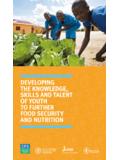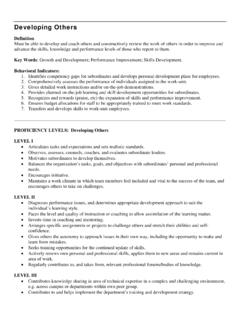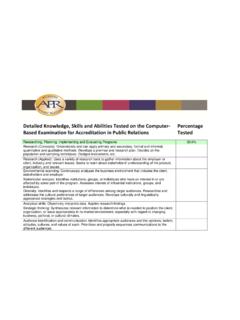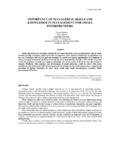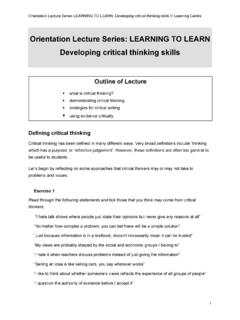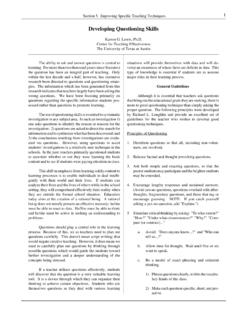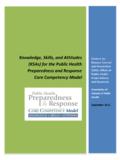Transcription of Preventing violence by developing life skills in …
1 Preventing violence by developing life skills in children and adolescentsSeries of briefings on violence preventionThis briefing for advocates, programme designers and implementers and others is one of a seven-part series on the evidence for interventions to prevent interper sonal and self-directed violence . The other six briefings look at reducing access to lethal means; increasing safe, stable and nurturing relationships between children and their parents and caregivers; reducing availability and misuse of alcohol; promoting gen-der equality; changing cultural norms that support violence ; and victim identification, care and support. For a searchable evidence base on interventions to prevent violence , please go to: a library of violence prevention publications, including the other briefings in this series, please go to: World Health Organization 2009 All rights reserved.
2 Publications of the World Health Organization can be obtained from WHO Press, World Health Organization, 20 Avenue Appia, 1211 Geneva 27, Switzerland (tel.: +41 22 791 3264; fax: +41 22 791 4857; e-mail: Requests for permission to reproduce or translate WHO publications whether for sale or for noncommercial distribution should be addressed to WHO Press, at the above address (fax: +41 22 791 4806; e-mail: The designations employed and the presentation of the material in this publication do not imply the expression of any opinion whatsoever on the part of the World Health Organization concerning the legal status of any country, territory, city or area or of its authorities, or concerning the delimitation of its frontiers or boundaries. Dotted lines on maps represent approximate border lines for which there may not yet be full mention of specific companies or of certain manufacturers products does not imply that they are endorsed or recommended by the World Health Organization in preference to others of a similar nature that are not mentioned.))
3 Errors and omissions excepted, the names of proprietary products are distinguished by initial capital reasonable precautions have been taken by the World Health Organization to verify the information contained in this publication. However, the published material is being distributed without warranty of any kind, either expressed or implied. The responsibility for the interpretation and use of the material lies with the reader. In no event shall the World Health Organization be liable for damages arising from its by minimum graphicsPrinted in MaltaWHO Library Cataloguing-in-Publication Data : Preventing violence by developing life skills in children and adolescents. (Series of briefings on violence prevention: the evidence) prevention and control. relations. behavior. behavior. support. Health Organization. ISBN 978 92 4 159783 8 (NLM classification: HV 6625) OverviewViolence among children and youth is a public health problem, day, worldwide, an estimated 227 children and youths (age 0 19 years) die as a result of interpersonal violence , and for each death many more are hospitalized with injuries.
4 Poor social skills , low academic achievement, impulsiveness, truancy and poverty are among the factors that fuel this violence can be prevented by developing the life skills of young children. life skills are cognitive, emotional, interpersonal and social skills that enable individuals to deal effectively with the challenges of everyday life . Evidence shows that preschool enrichment and social development programmes, which target children early in life , can prevent aggression, improve social skills , boost educational achievement and improve job prospects. These effects are most pronounced in children from poor families and neighbourhoods. The benefits of high-quality programmes of this type can also be sustained into adulthood. Programmes for older children and youth also improve effects of academic enrichment programmes, incentives to complete schooling and vocational training programmes on violence prevention demand further research, though studies have found some positive effects.
5 These may be short-lived, however, and some programmes for adolescents have even shown detrimental effects. Further research is needed to improve our knowledge of the effects of life - skills programmes, particularly in developing research on life skills programmes has been conducted in high-income countries, particularly the United States of America. More evidence is needed on the impacts of preschool enrichment and social development programmes in low- and middle-income countries. Although evidence for the violence prevention effects of other types of programmes is limited, vocational training has been to shown to improve employment prospects most significantly in low- and middle-income 1 life skillsLife skills can be defined as abilities for adaptive and positive behaviour that enable individuals to deal effectively with the demands and challenges of everyday life (4).
6 These include cognitive, emotional, interpersonal and social skills to foster:L SELF-AWARENESS: self-esteem and confidence building, self-monitoring, self-evaluation, goal setting, etc; L SELF-MANAGEMENT: anger and stress management, time management, coping skills , controlling impulses, relaxation, etc; L SOCIAL AWARENESS: empathy, active listening, recognizing and appreciating individual and group differences, etc;L RELATIONSHIPS: negotiation, conflict management, resisting peer pressure, networking, motivation, etc; andL RESPONSIBLE DECISION-MAKING: Information gathering, critical thinking, evaluating consequences of actions, etc. (5,6)3 Preventing violence BY developing life skills IN CHILDREN AND ADOLESCENTS1. IntroductionEvery day, worldwide, an estimated 227 children and youths (age 0 19 years) die as a result of inter-personal violence (1), and for each death many more are hospitalized with injuries from this violence (2).
7 Factors such as poor social competence, low aca-demic achievement, impulsiveness, truancy and poverty increase individuals risk of violence (2,3). Thus, developing children s life skills (see Box 1), improving their participation and performance in school and increasing their prospects for employ-ment can help protect them from violence , both in childhood and later in life . Interventions for de-veloping life skills can help young people to avoid violence , by improving their social and emotional competencies, teaching them how to deal effective-ly and non-violently with conflict and helping them to find employment. This briefing outlines evidence of the impact1 of violence prevention measures that aim to develop life skills in children and adoles-cents. It focuses on five types of programmes:BOX 1 life skillsLife skills can be defined as abilities for adaptive and positive behaviour that enable individuals to deal effectively with the demands and challenges of everyday life (4).
8 These include cognitive, emotional, interpersonal and social skills to foster:L SELF-MANAGEMENT: anger and stress management, time management, coping skills , controlling L SOCIAL AWARENESS: empathy, active listening, recognizing and appreciating individual and group L RELATIONSHIPS: negotiation, conflict management, resisting peer pressure, networking, motivation, L RESPONSIBLE DECISION-MAKING: Information gathering, critical thinking, evaluating consequences of Preschool enrichment programmes, which aim to increase children s school prepared-ness and chances of academic success by providing them with early academic and so-cial skills ; Social development programmes, which seek to provide children with social and emotional skills to solve problems, empathize and deal with conflict; Academic enrichment programmes, which aim to improve academic achievement with study support and other activities outside normal school hours; 1 Wherever possible, evidence is drawn from studies that measure the impact of interventions on violent behaviour.
9 However, many studies do not measure violence per se, but rather criminal justice outcomes such as arrests. Where evi-dence is not available on either of these outcomes, other be-havioural outcomes have been used to show impacts on risk and protective factors for violence . differences, etc.;impulses, relaxation, etc.; L SELF-AWARENESS: self-esteem and confidence building, self-monitoring, self-evaluation, goal setting, etc.; etc.; andactions, etc. (5,6).4 violence PREVENTION: THE EVIDENCE Incentives for youths to complete education, including financial incentives for young peo-ple to attend and complete school and pur-sue higher education; and Vocational training for underprivileged youths to increase their chances of finding employment and divert them from practice, these types of programmes often over-lap.
10 For example, preschool enrichment and social development programmes are frequently combined in interventions for young children (7), while inter-ventions targeting adolescents can include both academic enrichment and incentives for completing education (8). Of the five programme types, the evidence for preschool enrichment and social development programmes is by far the most robust, with high- quality studies associating these early interven-tions with reduced aggressive behaviour and vio-lent crime in childhood and later in life . Evidence for the effectiveness of academic enrichment, in-centive and vocational training programmes, how-ever, is currently limited; few rigorous studies have measured the impact of these intervention types on violence , and existing studies show mixed results.










